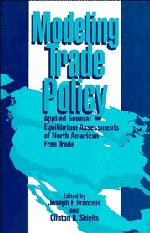Book contents
11 - Toward a Dynamic General Equilibrium Model of North American Trade
Published online by Cambridge University Press: 25 March 2010
Summary
Introduction
The current tool of choice for analyzing the impact of the North American Free Trade Agreement (NAFTA) on the economies of Canada, Mexico, and the United States is the static applied general equilibrium model. Examples of such analyses include Brown, Deardorff, and Stern (1991); Cox and Harris (1991); Hinojosa-Ojeda and Robinson (1991); KPMG Peat-Marwick (1991); Sobarzo (1991); and Yúnez-Naude (1991). They all tend to find small, but favorable, impacts of such an agreement.
Static applied general equilibrium models can do a good job in analyzing, and even in predicting, the impact of trade liberalization or tax reform on relative prices and resource allocation over a short time horizon. Kehoe, Polo, and Sancho (1991), for example, assess the performance of a static general equilibrium model of the Spanish economy that had been constructed to analyze the impact of the tax reform that accompanied Spain's 1986 entry into the European Economic Community. They find that the model was able to account for more than two-thirds of the variation of relative prices that occurred between 1985 and 1987. (It would be interesting to do similar ex post performance evaluations of the analyses of NAFTA.)
Typically, however, this sort of model predicts small changes in economic welfare [see Shoven and Whalley (1984); Whalley (1989)]. One reason for this is that these models do not attempt to capture the impact of government policy on growth rates. For this we need a dynamic model.
- Type
- Chapter
- Information
- Modeling Trade PolicyApplied General Equilibrium Assessments of North American Free Trade, pp. 328 - 348Publisher: Cambridge University PressPrint publication year: 1994



